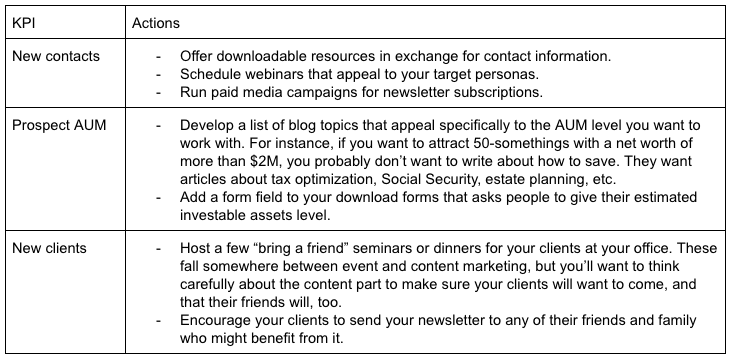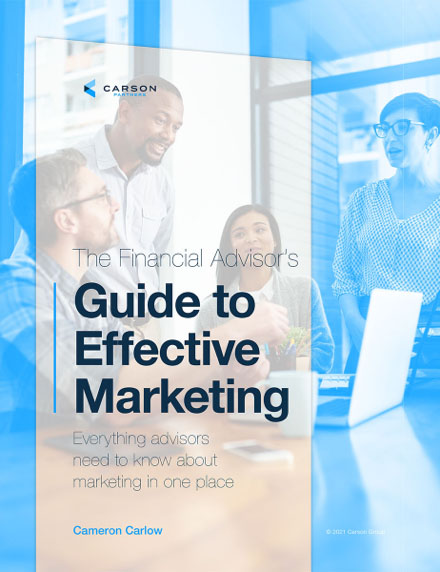Content marketing’s scope and importance keeps growing and growing. It includes videos, commercials, blogs, social media and more. Some advisors do it really well, but we’ve seen a lot who jump into the deep end and end up doggy-paddling in circles, because they don’t have a plan.
“The essence of strategy is choosing what not to do.”
Michael Porter, Harvard Business School
I love this quote, because it helps me approach marketing in an age where anything is possible with the mindset of “Should we do this?” rather than “Can we do this?” The answer to the latter question is pretty much always yes, but you can’t do everything. Instead we need to spend our time well by honing in on what we should be doing.
With that in mind, we’ve compiled a list of 12 questions to help you set a clear path for your firm’s content marketing that will help you get where you want to go.
(Shameless plug: I hosted a webinar on this topic with our Content Director, Cameron Carlow, called “How to Create a Content Strategy That Will Really Move the Needle.” If you have 40 minutes to invest in getting better at marketing, I think it’s worth your time.)
1. What is our ultimate goal?
In the introduction to his book “Key Performance Indicators,” David Parmenter beautifully sums up the importance of having an ultimate goal:
Many organizations fail to achieve their potential, because they have not distinguished their critical success factors. This lack of clarity means that staff members often will schedule their work around their team’s priorities rather than the priorities of the organization.
In other words, before you start building your content marketing strategy, you have to know what strategic direction you want it to take you.
That’s why the first question is about your ultimate goal. There are so many marketing metrics to help you keep track of how you’re doing – blog views, ad click-throughs, social engagement, webinar conversions – that it’s easy to “lose the plot” along the way. At some point, you might find yourself caring more about number of clicks than number of new clients. I know that sounds crazy, but we’ve seen it happen many times.
Content marketing has the same goals as its big brother, marketing: more revenue, more clients, more market share, more wallet share with existing clients – the list goes on. They all center around one key word: growth. Of course, your goal can’t be just “growth,” because you can’t accomplish that on your own.
It’s like when you plant a garden. The actual growth of the plants comes through no effort of your own – you just provide premium conditions for nature to do its thing.
Growth is the result of effective marketing, effective marketing requires a strategy, and strategy requires a goal.
So what is yours? $____M NNA by end of year? Increase AUM by 10%? ___ new clients over $___M? Whatever your ultimate goal is, make sure everyone in your company knows it and that your content marketing strategy is centered around it.
One important note to keep in mind here: Content marketing alone does not a growth strategy make. It’s an important piece of the puzzle, but your overall plan needs to include other important areas like client referrals, centers of influence, M&A and more.
Related Video: “Developing an M&A Strategy to Help Your Business Soar,” with Jason Carver, Carson’s VP of Mergers & Acquisitions
https://carsongroup.wistia.com/medias/ogxl0rdrhg?embedType=async&seo=false&videoFoam=true&videoWidth=640
2. What KPIs should we watch to make sure we’re moving toward our ultimate goal?
Key performance indicators are what David Parmenter is talking about when he refers to “myriad success factors” in the excerpt above. In the digital age, basically everything is measurable, which is great, but the downside is that, well, basically everything is measurable.
Yes, every KPI is measurable, but not everything that can be measured is a KPI. The key word in KPI is “key.” So your job at this point is to figure out which KPIs are key to your ultimate goal. If your goal is about new clients, then your KPIs will likely center around new contacts, paid media conversions, prospect AUM, new clients, time in pipeline, and a few others.
This is why it’s so important to keep your ultimate goal in mind. You might find yourself frustrated when your latest Facebook campaign only brings in three leads in its first month, but if one or two of those prospects is in your sweet spot in terms of AUM and persona, then it was money well spent.
So what KPIs matter to your company? Look at your ultimate goal and then choose a few – every company is different, but try to keep it to fewer than 20 – that point in the same strategic direction.
3. How could we get results on those KPIs?
With your KPIs in mind, it’s time to brainstorm how you’ll move the needle in those key areas. Let’s look at a few sample KPIs and some actions you could take to move them in the right direction.
Hold a brainstorming session with your entire team and write down every suggestion.
4. What are our strengths?
Evaluate your list and ask yourself, “What are my team’s strengths?”
- Nancy is really good on camera, so she could host a Youtube series.
- Mike loves writing (and is good at it!), so he could write a blog every month.
- Don loves writing (and is so-so at it), so he could write the first draft of your newsletter.
- We all love social media, so we could all help write posts for Facebook and Twitter.
Circle the ideas that play to your team’s strengths the most clearly.
5. What should we avoid?
Cross out the ideas that don’t make any sense for your team. Be brutally honest. Sure, you may love making videos, but are you awkward on camera? And yes, Twitter can be a lot of fun, but do your personas spend any time on there? All those #fintwit conversations are fun to be a part of, but the number of retweets your GIF gets probably shouldn’t count as a KPI.
6. Who is our target audience?
I’ve mentioned personas a couple times already, but now is the time to drill down and make sure you’re thinking about your ideal audience. If you don’t have personas, then I would strongly recommend getting yours nailed down before going any further with your content strategy.
(Pro tip: We created a summary of the 11 most common investor personas that you can download to help you get started. Developing personas is a big task, and this resource will help you leapfrog over everyone else who is staring at a blank screen unsure where to begin. Click the button below to get yours.)
7. What are your personas interested in reading?
Once you know who your personas are, develop a list of topics they’re interested in. Ask your favorite clients, send your team a poll, consult with your advisory council – you’ll quickly put together a great list of ideas to choose from. Once you have a list, develop a content calendar and assign the articles out to your chosen authors.
For more info on developing a content calendar, check out our webinar, “How to Create a Content Strategy That Will Really Move the Needle.”
8. What channels should we use to promote our content?
So you have a blog and a Facebook company page for your firm. That’s great! Now what should you add?
*Deep breath*: Youtube, Medium, Twitter brand accounts, Twitter personal accounts, Linkedin, Linkedin groups, TikTok, Instagram, Instagram stories, social media ads, Snapchat, podcasts, Reddit, email, Facebook personal accounts, Facebook groups, SlideShare, Pinterest…
The list of channels available for publishing content nowadays is long. Find an exhaustive list and determine which ones make the most sense for your company.
Implied in this question is “What channels don’t make sense for us to use?”
Avoid the temptation to give someone the vague job of “promoting our content on social media.” Get specific.
Consider the following factors when making your decision:
- Your ultimate goal
- Your personas
- The channel’s user demographics
For instance, the majority of TikTok users are under the age of 24 – a demographic few non-robo-advisors covet.
In contrast, high net worth individuals have traditionally stuck to Facebook and Linkedin, although several others have risen in popularity in recent years, including Youtube and Instagram.
- The channel’s popularity
9. What is our ultimate goal?
This is a good place to check in and remind yourself why you’re doing all of this. Does the work you’ve done so far all point toward your ultimate goal in some way?
10. How will we approach social media?
Hard truth time: Most advisors are doing social wrong. Social media is a conversation, but the majority of advisors treat it as a bulletin board. They post their latest musings and then wonder why no one pays any attention to them.
To make any traction on social, you need to engage with your audience. If someone comments on your posts, respond! Encourage conversations by tagging people and incorporating hashtags where appropriate.
Determine a plan of action for social media that answers these questions:
- Will you post to a company social page, team member’s individual pages, or a combination of both?
- Who will monitor comments?
- Who will respond to comments?
- Who will review and approve those responses? (This can help you avoid emotional posting, which only leads to trouble.)
- What topics will we avoid? (Politics, religion, etc.)
11. How will we monitor our progress?
If you’re not monitoring your marketing efforts, then you’ll have no idea how successful you are. Set up Google Analytics, connect everything to your digital marketing management system (e.g., Hubspot, Mailchimp, Constant Contact), use link-tracking software like Bitly, use social media monitoring software like Hootsuite or Buffer – however you want to do it, make sure you track your progress.
Tracking allows you to know what’s working and what’s not working – and it gives you that all-important opportunity: the chance to get better.
12. What is our ultimate goal?
One last check-in, I swear. 😃
Now that you’ve thought through everything, look back. Did you get off track at any point?
Now that you have a content marketing strategy in place, all that’s left to do is implement it! Happy writing!
At Carson, we create an annual marketing plan for our partner firms to help them create relevant, engaging content that connects with their ideal audiences. Want to know what else we do for Carson Partners? Download the Carson Partnership Guide below!
*Featured Photo by Caleb Jones on Unsplash






